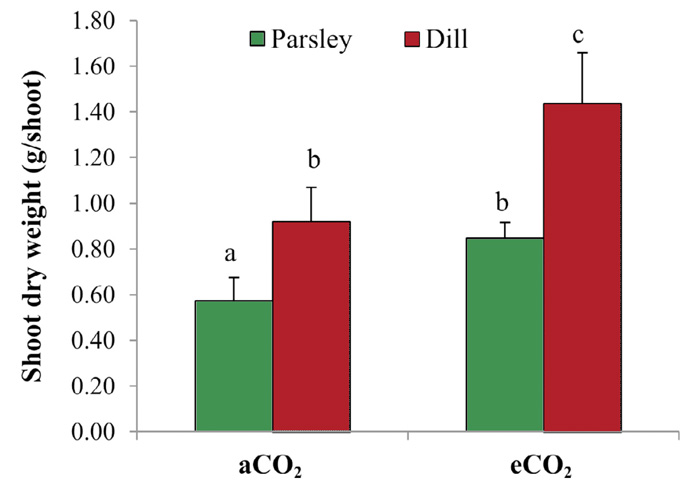| Tweet | Follow @co2science |
Paper Reviewed
Saleh, A.M., Selim, S., Jaouni, S.A. and AbdElgawad, H. 2018. CO2 enrichment can enhance the nutritional and health benefits of parsley (Petroselinum crispum L.) and dill (Anethum graveolens L.). Food Chemistry 269: 519-526.
Writing as background for their intriguing new study, Saleh et al. (2018) note that "parsley and dill are valuable sources of minerals, vitamins, unsaturated fatty acids, phenolic acids, flavonoids and other bioactive compounds that support their nutritional and medicinal benefits," citing the works of Slupski et al. (2005), Parry et al. (2006), Lisiewska et al. (2006) and Karkleliene et al. (2014). Furthermore, they write that these two herbs are "recognized for their antioxidant, antibacterial, antifungal, anti-inflammatory, antidiabetic and anticancer activities, citing the additional works of Wong and Kitts (2006), Farshori et al. (2013) and Chahal et al. (2017). Yet despite the well-documented nutritional and health-promoting benefits of these two plants, little is known about the potential effects of rising atmospheric CO2 concentrations on these important plant properties/qualities.
Hoping to remedy this lack of knowledge, the team of four researchers set out to investigate the impact of elevated CO2 on the nutritional and health-promoting qualities of parsley (Petroselinum crispum) and dill (Anethum graveolens). In so doing, Saleh et al. grew plant seedlings in pots in controlled environment chambers under either ambient (378 ppm) or elevated (627 ppm) CO2 levels over a period of four weeks. And at the end of this interval, they conducted a series of analyses to measure the impact of atmospheric CO2 concentration on the concentrations of 81 metabolites and minerals.
In discussing their findings, Saleh et al. report that elevated CO2 significantly improved parsley and dill biomass production by a measure of approximately 1.5-fold relative to ambient-grown plants (see Figure 1). More importantly, however, the authors found that elevated CO2 "triggered improvements in the levels of soluble sugars, starch, organic acids, some essential amino acids, most of [the] unsaturated fatty acids, total phenolics, total flavonoids and vitamins A and E." Moreover, they note that "parallel improvements in the total antioxidant capacity, antiprotozoal, antibacterial and anticancer activities were recorded for parsley and dill in response to elevated CO2." Additionally, elevated CO2 did not affect the levels of four plant macronutrients (K, Ca, Mg, and P) or micronutrients (Zn, Cu, Fe, and MN), with the exception of Ca and Zn, the concentrations of which were significantly enhanced in dill and parsley, respectively.
Consequently, in light of all of the above findings, it should come as no surprise that Saleh et al. conclude that "manipulation of elevated CO2 as a strategy to improve the growth and nutritional and health benefits of herbal plants is worthwhile." Yet with all this good news about the beneficial effects of higher atmospheric CO2 levels, why is it that you have likely not heard of them until now?

Figure 1. Shoot biomass of parsley and dill grown under two levels of CO2, ambient (378 ppm, aCO2) and elevated (627 ppm, eCO2). Values are means ± standard errors of three independent replicates. Same lower-case letters on bars indicate no significant difference at the 0.05 probability level. Source: Selah et al. (2018).
References
Chahal, K.K., Kumar, A., Bhardwaj, U. and Kaur, R. 2017. Chemistry and biological activities of Anethum graveolens L. (dill) essential oil: a review. Journal of Pharmacognosy and Phytochemistry 6: 295-306.
Farshori, N.N., Al-Sheddi, E.S., Al-Oqail, M.M. and Siddiqui, M.A. 2013. Anticancer activity of Petroselinum sativum seed extracts on MCF-7 human breast cancer. Asian Pacific Journal of Cancer Prevention 14: 5719-5723.
Karkleliene, R., Dambrauskiene, E., Juskeviciene, D., Radzevicius, A., Rubinskiene, M. and Viskelis, P. 2014. Productivity and nutritional value of dill and parsley. Horticultural Science 41: 131-137.
Lisiewska, Z., Kmiecik, W. and Korus, A. 2006. Content of vitamin C, carotenoids, chlorophylls and polyphenols in green parts of dill (Anethum graveolens L.) depending on plant height. Journal of Food Composition and Analysis 19: 134-140.
Parry, J., Hao, Z., Luther, M., Su, L., Zhou, K. and Yu, L. 2006. Characterization of coldpressed onion, parsley, cardamom, mullein, roasted pumpkin, and milk thistle seed oils. Journal of the American Oil Chemists' Society 83: 847-854.
S?upski, J., Lisiewska, Z. and Kmiecik, W. 2005. Contents of macro and microelements in fresh and frozen dill (Anethum graveolens L.). Food Chemistry 91: 737-743.
Wong, P.Y.Y. and Kitts, D.D. 2006. Studies on the dual antioxidant and antibacterial properties of parsley (Petroselinum crispum) and cilantro (Coriandrum sativum) extracts. Food Chemistry 97: 505-515.
Posted 5 October 2018



